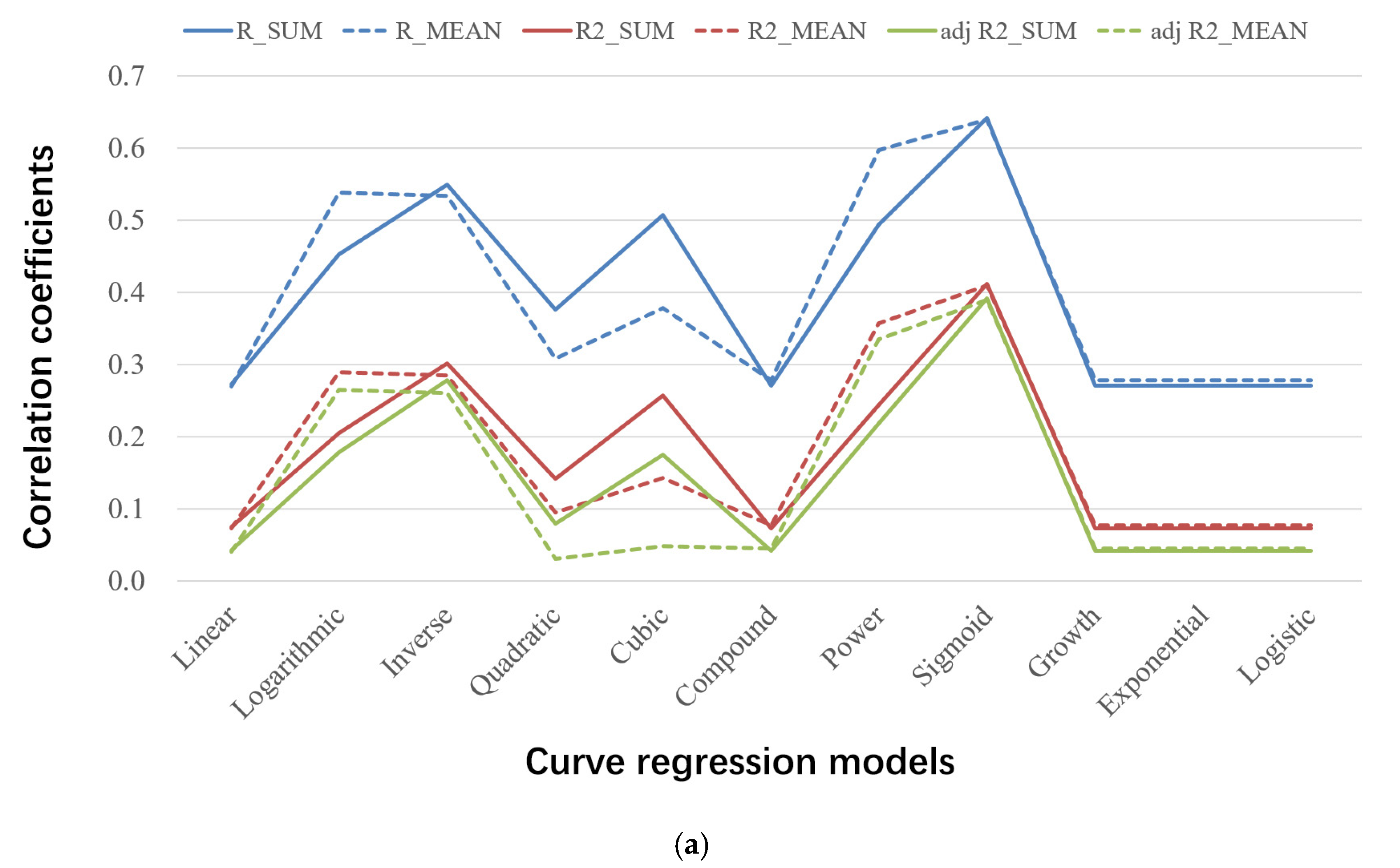Prediction of the Old-Age Dependency Ratio in Chinese Cities Using DMSP/OLS Nighttime Light Data
Abstract
:1. Introduction
2. Background
2.1. Nighttime Light Data
2.2. Prediction of the ODR
2.3. Spatial Correlation Analysis of the ODR
3. Methods
3.1. Data Sources and Preprocessing
3.1.1. Data Sources
3.1.2. Data Preprocessing
3.2. ODR Prediction Model Based on the Curve Estimation
3.2.1. Predictors
- (1)
- ODR is an important indicator reflecting the degree of regional population aging from the economic perspective, also known as the old-age dependency coefficient, which refers to the ratio of the old-age population to the working-age population [37], as shown in Equation (1).where is the old-age population aged 65 and over; is the working-age population aged 15~64.
- (2)
- Nighttime light data are closely related to social-economic life and human activity intensity and can reflect the development of population [38]. ODR is a key indicator in population research, and based on the literature review, it is appropriate to use DMSP/OLS nighttime light data to predict the ODR in large and medium-sized cities in China, and thus the study about the relationship information between DMSP/OLS nighttime light data and ODR.
3.2.2. Modeling
3.3. ODR Spatial Correlation Based on the Moran’s I Index
3.3.1. Global Spatial Autocorrelation Theory
3.3.2. Local Spatial Autocorrelation Theory
4. Results
4.1. Analysis of the Prediction Results of the Municipal ODR
4.2. Spatial Correlation Analysis of the Municipal ODR
5. Discussion
5.1. Regional Differences between the ODR and Nighttime Light Data
5.2. Policy Implications
- (1)
- Greater emphasis should be placed on the regional variances in the ODR. For example, cities with high nighttime light brightness should develop a local system of old-age care. Attention should also be given to the old-age care in towns with a high ODR where the population has migrated out. Additionally, central financial transfer payments and long-term care insurance should be implemented to ensure the supply of old-age care [61].
- (2)
- To alleviate aging, the elderly should be immersed in the activities of the common prosperity objective where they can discover their self-worth through time banking programs [62]. As the capital with a relatively high ODR, Beijing officially launched the “Project of Time Banking for Elderly Services” in 2022. Studies have shown that elderly individuals can build their social capital by participating in community life, allowing them to independently and happily age in peace.
- (3)
- Family support policies could also alleviate the regional disparity in the ODR. China implemented the “Three-Child Policy” in 2021. Due to the cohort effect, this policy would not be conducive to solving the current pension crisis and will raise the social dependency ratio [63,64]. As a result, it is critical to implement suitable strategies to address the rapidly changing demographics. For example, for young talents, policymakers could consider providing them with more favorable policies that allow them to cohabit with their parents. The income disparity between regions can be decreased through industrial transfer and other measures for young workers.
6. Conclusions
7. Further Research
Author Contributions
Funding
Institutional Review Board Statement
Informed Consent Statement
Data Availability Statement
Acknowledgments
Conflicts of Interest
Appendix A. Modeling Process


| Province | Provincial SUM of DN | Provincial MEAN of DN | Provincial ODR (%) | Province | Provincial SUM of DN | Provincial MEAN of DN | Provincial ODR (%) |
|---|---|---|---|---|---|---|---|
| Beijing | 348,231 | 21.22 | 17.77 | Hunan | 614,523 | 2.90 | 22.56 |
| Tianjin | 349,408 | 28.88 | 20.56 | Guangdong | 2,076,629 | 11.43 | 11.82 |
| Hebei | 1,609,944 | 8.54 | 21.14 | Guangxi | 661,632 | 2.79 | 19.01 |
| Shanxi | 981,743 | 6.26 | 18.24 | Hainan | 260,939 | 5.99 | 14.99 |
| Inner Mongolia | 941,327 | 0.82 | 17.90 | Chongqing | 300,330 | 3.65 | 25.48 |
| Liaoning | 1,034,012 | 6.98 | 24.37 | Sichuan | 804,188 | 1.65 | 25.28 |
| Jilin | 612,406 | 3.21 | 21.47 | Guizhou | 362,748 | 2.06 | 17.92 |
| Heilongjiang | 1,263,697 | 2.79 | 21.08 | Yunnan | 750,280 | 1.96 | 15.42 |
| Shanghai | 334,746 | 41.95 | 22.02 | Tibet | 49,183 | 0.04 | 8.13 |
| Jiangsu | 2,171,169 | 20.95 | 23.61 | Shaanxi | 862,672 | 4.20 | 19.21 |
| Zhejiang | 1,361,539 | 12.69 | 18.10 | Gansu | 487,820 | 1.15 | 18.50 |
| Anhui | 980,574 | 7.00 | 22.83 | Qinghai | 129,387 | 0.19 | 12.31 |
| Fujian | 881,809 | 7.06 | 15.95 | Ningxia | 214,371 | 4.13 | 13.74 |
| Jiangxi | 483,089 | 2.89 | 17.97 | Xinjiang | 874,442 | 0.54 | 11.12 |
| Shandong | 2,314,851 | 14.66 | 22.90 | Mean value | 850,516.26 | 7.80 | 18.83 |
| Henan | 1,500,920 | 9.06 | 21.28 | Correlation coefficient | 0.260 * | 0.258 * | |
| Hubei | 747,395 | 4.02 | 21.11 | Significance of the correlation coefficients | 0.040 | 0.041 |
| Summary | Parameter Estimates | |||||||||||
|---|---|---|---|---|---|---|---|---|---|---|---|---|
| No. | Model | R | R2 | Adjusted R2 | F | df1 | df2 | Sig. | Constant | b1 | b2 | b3 |
| 1 | Linear | 0.273 | 0.075 | 0.043 | 2.336 | 1 | 29 | 0.137 | 17.143 | 1.985 × 10−6 | ||
| 2 | Logarithmic | 0.453 | 0.206 | 0.178 | 7.501 | 1 | 29 | 0.010 | −11.977 | 2.304 | ||
| 3 | Inverse | 0.549 | 0.302 | 0.278 | 12.542 | 1 | 29 | 0.001 | 20.421 | −6.493 × 105 | ||
| 4 | Quadratic | 0.376 | 0.141 | 0.080 | 2.303 | 2 | 28 | 0.119 | 14.716 | 8.328 × 10−6 | −2.788 × 10−12 | |
| 5 | Cubic | 0.507 | 0.257 | 0.175 | 3.117 | 3 | 27 | 0.043 | 10.412 | 2.958 × 10−5 | −2.682 × 10−11 | 7.021 × 10−18 |
| 6 | Compound | 0.271 | 0.073 | 0.041 | 2.296 | 1 | 29 | 0.141 | 16.488 | 1.000 | ||
| 7 | Power | 0.494 | 0.244 | 0.218 | 9.381 | 1 | 29 | 0.005 | 2.336 | 0.154 | ||
| 8 | Sigmoid | 0.642 | 0.412 | 0.392 | 20.336 | 1 | 29 | 0.000 | 3.019 | −4.644 × 104 | ||
| 9 | Growth | 0.271 | 0.073 | 0.041 | 2.296 | 1 | 29 | 0.141 | 2.803 | 1.205 × 10−7 | ||
| 10 | Exponential | 0.271 | 0.073 | 0.041 | 2.296 | 1 | 29 | 0.141 | 16.488 | 1.205 × 10−7 | ||
| 11 | Logistic | 0.271 | 0.073 | 0.041 | 2.296 | 1 | 29 | 0.141 | 0.061 | 1.000 | ||
| Summary | Parameter Estimates | |||||||||||
|---|---|---|---|---|---|---|---|---|---|---|---|---|
| No. | Model | R | R2 | Adjusted R2 | F | df1 | df2 | Sig. | Constant | b1 | b2 | b3 |
| 1 | Linear | 0.270 | 0.073 | 0.041 | 2.280 | 1 | 29 | 0.142 | 17.857 | 0.125 | ||
| 2 | Logarithmic | 0.538 | 0.289 | 0.265 | 11.812 | 1 | 29 | 0.002 | 16.657 | 1.609 | ||
| 3 | Inverse | 0.534 | 0.285 | 0.260 | 11.553 | 1 | 29 | 0.002 | 19.490 | −0.511 | ||
| 4 | Quadratic | 0.309 | 0.095 | 0.031 | 1.473 | 2 | 28 | 0.246 | 17.155 | 0.316 | −0.005 | |
| 5 | Cubic | 0.378 | 0.143 | 0.048 | 1.505 | 3 | 27 | 0.236 | 15.893 | 0.890 | −0.049 | 0.001 |
| 6 | Compound | 0.278 | 0.077 | 0.045 | 2.430 | 1 | 29 | 0.130 | 17.179 | 1.008 | ||
| 7 | Power | 0.597 | 0.357 | 0.335 | 16.095 | 1 | 29 | 0.000 | 15.757 | 0.109 | ||
| 8 | Sigmoid | 0.640 | 0.410 | 0.389 | 20.126 | 1 | 29 | 0.000 | 2.953 | −0.038 | ||
| 9 | Growth | 0.278 | 0.077 | 0.045 | 2.430 | 1 | 29 | 0.130 | 2.844 | 0.008 | ||
| 10 | Exponential | 0.278 | 0.077 | 0.045 | 2.430 | 1 | 29 | 0.130 | 17.179 | 0.008 | ||
| 11 | Logistic | 0.278 | 0.077 | 0.045 | 2.430 | 1 | 29 | 0.130 | 0.058 | 0.992 | ||
References
- Wang, Y.; Zhou, C. Promoting Social Engagement of the Elderly to Cope with Aging of the Chinese Population. BioSci. Trends 2020, 14, 310–313. [Google Scholar] [CrossRef]
- Peng, X. China’s Demographic History and Future Challenges. Science 2011, 333, 581–587. [Google Scholar] [CrossRef] [PubMed]
- Kaihao, L.; Yu, L. Domestic Demand Growth in China: Analysis through a Demographic Approach. Anthropologist 2016, 23, 480–496. [Google Scholar] [CrossRef]
- Bhagat, R.B.; Unisa, S. Ageing and Dependency in India: A New Measurement. Asian Popul. Stud. 2006, 2, 201–214. [Google Scholar] [CrossRef]
- Verdugo, R.R. Workers, Workers’ Productivity and the Dependency Ratio in Germany: Analysis with Implications for Social Policy. Popul. Res. Policy Rev. 2006, 25, 547–565. [Google Scholar] [CrossRef]
- Santacreu, A.M. Long-Run Economic Effects of Changes in the Age Dependency Ratio. Econ. Synop. 2016, 17, 1–2. [Google Scholar] [CrossRef]
- Zhang, Y.; Qiu, Z. The Analysis of the Risks Faced by China’s Social Endowment Insurance under the Back-Ground of Rapid Aging Population. Open J. Bus. Manag. 2015, 3, 185. [Google Scholar] [CrossRef]
- Hu, N.; Yang, Y. The Real Old-Age Dependency Ratio and the Inadequacy of Public Pension Finance in China. J. Popul. Ageing 2012, 5, 193–209. [Google Scholar] [CrossRef]
- Ediev, D.M.; Sanderson, W.C.; Scherbov, S. The Inverse Relationship between Life Expectancy-Induced Changes in the Old-Age Dependency Ratio and the Prospective Old-Age Dependency Ratio. Theor. Popul. Biol. 2018, 125, 1–10. [Google Scholar] [CrossRef]
- Deng, C.; Wu, C.; Wang, L. Improving the Housing-Unit Method for Small-Area Population Estimation Using Remote-Sensing and GIS Information. Int. J. Remote Sens. 2010, 31, 5673–5688. [Google Scholar] [CrossRef]
- Fan, Y.; Song, G.; Zhang, S.; Feng, Z. The Study on Regional Environmental Risk Based on GIS Population Model. Energy Procedia 2011, 11, 4148–4155. [Google Scholar] [CrossRef]
- Qiu, F.; Woller, K.L.; Briggs, R. Modeling Urban Population Growth from Remotely Sensed Imagery and TIGER GIS Road Data. Photogramm. Eng. Remote Sens. 2003, 69, 1031–1042. [Google Scholar] [CrossRef]
- Yu, S.; Zhang, Z.; Liu, F. Monitoring Population Evolution in China Using Time-Series DMSP/OLS Nightlight Imagery. Remote Sens. 2018, 10, 194. [Google Scholar] [CrossRef]
- Lu, D.; Wang, Y.; Yang, Q.; Su, K.; Zhang, H.; Li, Y. Modeling Spatiotemporal Population Changes by Integrating DMSP-OLS and NPP-VIIRS Nighttime Light Data in Chongqing, China. Remote Sens. 2021, 13, 284. [Google Scholar] [CrossRef]
- Wu, J.; Wang, Z.; Li, W.; Peng, J. Exploring Factors Affecting the Relationship between Light Consumption and GDP based on DMSP/OLS Nighttime Satellite Imagery. Remote Sens. Environ. 2013, 134, 111–119. [Google Scholar] [CrossRef]
- Wu, Y.; Jiang, M.; Chang, Z.; Li, Y.; Shi, K. Does China’s Urban Development Satisfy Zipf’s Law? A Multiscale Perspective from the NPP-VIIRS Nighttime Light Data. Int. J. Environ. Res. Public Health 2020, 17, 1460. [Google Scholar] [CrossRef]
- Huang, Q.; Yang, Y.; Li, Y.; Gao, B. A Simulation Study on the Urban Population of China Based on Nighttime Light Data Acquired from DMSP/OLS. Sustainability 2016, 8, 521. [Google Scholar] [CrossRef]
- Bennett, M.M.; Smith, L.C. Advances in Using Multitemporal Nighttime Lights Satellite Imagery to Detect, Estimate, and Monitor Socioeconomic Dynamics. Remote Sens. Environ. 2017, 192, 176–197. [Google Scholar] [CrossRef]
- Yi, K.; Tani, H.; Li, Q.; Zhang, J.; Guo, M.; Bao, Y.; Li, J. Mapping and Evaluating the Urbanization Process in Northeast China using DMSP/OLS Nighttime Light Data. Sensors 2014, 14, 3207–3226. [Google Scholar] [CrossRef]
- Tripathy, B.R.; Tiwari, V.; Pandey, V.; Elvidge, C.D.; Rawat, J.S.; Sharma, M.P.; Prawasi, R.; Kumar, P. Estimation of Urban Population Dynamics using DMSP-OLS Night-Time Lights Time Series Sensors Data. IEEE Sens. J. 2017, 17, 1013–1020. [Google Scholar] [CrossRef]
- Song, G.; Yu, M.; Liu, S.; Zhang, S. A Dynamic Model for Population Mapping: A Methodology Integrating a Monte Carlo Simulation with Vegetation-Adjusted Nighttime Light Images. Int. J. Remote Sens. 2015, 36, 4054–4068. [Google Scholar] [CrossRef]
- Bagan, H.; Yamagata, Y. Analysis of Urban Growth and Estimating Population Density Using Satellite Images of Nighttime Lights and Land-Use and Population Data. GISci. Remote Sens. 2015, 52, 765–780. [Google Scholar] [CrossRef]
- Wang, Y.; Huang, C.; Feng, Y.; Zhao, M.; Gu, J. Using Earth Observation for Monitoring SDG 11.3. 1-Ratio of Land Consumption Rate to Population Growth Rate in Mainland China. Remote Sens. 2020, 12, 357. [Google Scholar] [CrossRef]
- Sanderson, W.C.; Scherbov, S. Remeasuring Aging. Science 2010, 329, 1287–1288. [Google Scholar] [CrossRef]
- Lee, R.D.; Carter, L.R. Modeling and Forecasting U.S. Mortality. J. Am. Stat. Assoc. 1992, 87, 659–671. [Google Scholar] [CrossRef]
- Shang, H.L.; Booth, H.; Hyndman, R. Point and Interval Forecasts of Mortality Rates and Life Expectancy: A Comparison of Ten Principal Component Methods. Demogr. Res. 2011, 25, 173–214. [Google Scholar] [CrossRef]
- Chowdhury, M.; Allen, E.J. A Stochastic Continuous-Time Age-Structured Population Model. Nonlinear Anal. Theory Methods Appl. 2001, 47, 1477–1488. [Google Scholar] [CrossRef]
- Hyndman, R.J.; Zeng, Y.; Shang, H.L. Forecasting the Old-Age Dependency Ratio to Determine a Sustainable Pension Age. Aust. N. Z. J. Stat. 2021, 63, 241–256. [Google Scholar] [CrossRef]
- Li, Q.; Reuser, M.; Kraus, C.; Alho, J. Aging of a Giant: A Stochastic Population Forecast for China, 2001–2050. J. Popul. Res. 2009, 26, 21–50. [Google Scholar] [CrossRef]
- Wang, S. Spatial Patterns and Social-Economic Influential Factors of Population Aging: A Global Assessment from 1990 to 2010. Soc. Sci. Med. 2020, 253, 112963. [Google Scholar] [CrossRef]
- Xu, X.; Zhao, Y.; Zhang, X.; Xia, S. Identifying the Impacts of Social, Economic, and Environmental Factors on Population Aging in the Yangtze River Delta Using the Geographical Detector Technique. Sustainability 2018, 10, 1528. [Google Scholar] [CrossRef]
- Wu, P. Spatial Aggregation and Spatial Econometric Analysis of the Elderly Dependency Ratio. In Population Development Challenges in China; Springer: Singapore, 2020; pp. 217–232. [Google Scholar] [CrossRef]
- Li, F.; Liu, X.; Liao, S.; Jia, P. The Modified Normalized Urban Area Composite Index: A Satelliate-Derived High-Resolution Index for Extracting Urban Areas. Remote Sens. 2021, 13, 2350. [Google Scholar] [CrossRef]
- Tan, M.; Li, X.; Li, S.; Xin, L.; Wang, X.; Li, Q.; Xiang, W. Modeling Population Density Based on Nighttime Light Images and Land Use Data in China. Appl. Geogr. 2018, 90, 239–247. [Google Scholar] [CrossRef]
- Calka, B.; Bielecka, E.; Zdunkiewicz, K. Redistribution Population Data across a Regular Spatial Grid According to Buildings Characteristics. Geod. Cartogr. 2016, 65, 149–162. [Google Scholar] [CrossRef]
- Zhao, M.; Cheng, W.; Zhou, C.; Li, M.; Wang, N.; Liu, Q. GDP Spatialization and Economic Differences in South China based on NPP-VIIRS Nighttime Light Imagery. Remote Sens. 2017, 9, 673. [Google Scholar] [CrossRef]
- Han, X.; Cheng, Y. Consumption-and Productivity-Adjusted Dependency Ratio with Household Structure Heterogeneity in China. J. Econ. Ageing 2020, 17, 100276. [Google Scholar] [CrossRef]
- Doll, C.N.H.; Pachauri, S. Estimating Rural Populations without Access to Electricity in Developing Countries through Night-Time Light Satellite Imagery. Energy Policy 2010, 38, 5661–5670. [Google Scholar] [CrossRef]
- Leng, W.; He, G.; Jiang, W. Investigating the Spatiotemporal Variability and Driving Factors of Artificial Lighting in the Beijing-Tianjin-Hebei Region Using Remote Sensing Imagery and Socioeconomic Data. Int. J. Environ. Res. Public Health 2019, 16, 1950. [Google Scholar] [CrossRef]
- Pan, W.; Fu, H.; Zheng, P. Regional Poverty and Inequality in the Xiamen-Zhangzhou-Quanzhou City Cluster in China based on NPP/VIIRS Night-Time Light Imagery. Sustainability 2020, 12, 2574. [Google Scholar] [CrossRef]
- Wong, D.W.S. Issues in the Current Practices of Spatial Cluster Detection and Exploring Alternative Methods. Int. J. Environ. Res. Public Health 2021, 18, 9848. [Google Scholar] [CrossRef]
- Wang, S.; Luo, K.; Liu, Y.; Zhang, S.; Lin, X.; Ni, R.; Tian, X.; Gao, X. Economic Level and Human Longevity: Spatial and Temporal Variations and Correlation Analysis of per Capita GDP and Longevity Indicators in China. Arch. Gerontol. Geriatr. 2015, 61, 93–102. [Google Scholar] [CrossRef]
- Zhao, Z.; Jia, H.; Chen, M. Major Socioeconomic Driving Forces of Improving Population Health in China: 1978–2018. Popul. Dev. Rev. 2020, 46, 643–676. [Google Scholar] [CrossRef]
- Wu, L.; Huang, Z.; Pan, Z. The Spatiality and Driving Forces of Population Ageing in China. PLoS ONE 2021, 16, e0243559. [Google Scholar] [CrossRef] [PubMed]
- Chen, W.; Yan, C.; Li, W.; Yang, Y. Coupling System-Based Spatiotemporal Variation and Influence Factors Analysis of City Shrinkage in Henan. Pol. J. Environ. Stud. 2021, 30, 3497–3510. [Google Scholar] [CrossRef]
- Ji, X.; Li, X.; He, Y.; Liu, X. A Simple Method to Improve Estimates of County-Level Economics in China Using Nighttime Light Data and GDP Growth Rate. ISPRS Int. J. Geo-Inf. 2019, 8, 419. [Google Scholar] [CrossRef]
- Chen, R.; Xu, P.; Li, F.; Song, P. Internal Migration and Regional Differences of Population Aging: An Empirical Study of 287 Cities in China. BioSci.Trends 2018, 12, 132–141. [Google Scholar] [CrossRef] [PubMed]
- Chen, Z.; Yu, B.; Song, W.; Liu, H.; Wu, Q.; Shi, K.; Wu, J. A New Approach for Detecting Urban Centers and Their Spatial Structure with Nighttime Light Remote Sensing. IEEE Trans. Geosci. Remote Sens. 2017, 55, 6305–6319. [Google Scholar] [CrossRef]
- Chen, X. Nighttime Lights and Population Migration: Revisiting Classic Demographic Perspectives with an Analysis of Recent European Data. Remote Sens. 2020, 12, 169. [Google Scholar] [CrossRef]
- Xiao, Q.; Wang, Y.; Zhou, W. Regional Economic Convergence in China: A Comparative Study of Nighttime Light and GDP. Front. Phys. 2021, 9, 525162. [Google Scholar] [CrossRef]
- Man, W.; Wang, S.; Yang, H. Exploring the Spatial-Temporal Distribution and Evolution of Population Aging and Social-Economic Indicators in China. BMC Public Health 2021, 21, 966. [Google Scholar] [CrossRef]
- Chen, M.; Lloyd, C.J.; Yip, P.S. Growing Rich without Growing Old: The Impact of Internal Migration in China. Asian Popul. Stud. 2020, 16, 183–200. [Google Scholar] [CrossRef]
- Chen, G. Building, Integrating, and Sharing Our Aging Society: Improving Older Adults’ Health Together. China CDC Wkly. 2021, 3, 835. [Google Scholar] [CrossRef] [PubMed]
- Gal, Z. Immigration in the United States and the European Union. Helping to Solve the Economic Consequences of Ageing? Sociológia 2018, 1, 35–61. [Google Scholar] [CrossRef]
- Zhang, T.; Liu, J.; Liu, C. Changes in Perceived Accessibility to Healthcare from the Elderly between 2005 and 2014 in China: An Oaxaca-Blinder Decomposition Analysis. Int. J. Environ. Res. Public Health 2019, 16, 3824. [Google Scholar] [CrossRef] [PubMed]
- Zhang, P.; Lv, Y.; Li, Z.; Yin, Z.; Li, F.; Wang, J.; Zhang, X.; Zhou, J.; Wu, X.; Duan, J.; et al. Age, Period and Cohort Effects in Activities of Daily Living, Physical and Cognitive Functioning Impairment among the Oldest-Old in China. J. Gerontol. Ser. A 2020, 75, 1214–1221. [Google Scholar] [CrossRef]
- Cai, Y.; Wang, F. The Social and Sociological Consequences of China’s One-Child Policy. Annu. Rev. Sociol. 2021, 47, 587–606. [Google Scholar] [CrossRef]
- Li, Y.; Pan, Y.; Chen, Y.; Cui, P. Important Dependency-Associated Community Resources among Elderly Individuals with a Low Level of Social Support in China. Int. J. Environ. Res. Public Health 2021, 18, 2754. [Google Scholar] [CrossRef]
- Cui, P.; Chen, Y.; Li, Y.; Wali, N.; Li, Y. The Role of Social Support in the Association between Dependency and Important Risk Factors among the Elderly. Psychogeriatrics 2021, 21, 317–323. [Google Scholar] [CrossRef]
- Leung, J.C.B. Family Support for the Elderly in China. J. Aging Soc. Policy 1997, 9, 87–101. [Google Scholar] [CrossRef]
- Du, P.; Dong, T.; Ji, J. Current Status of the Long-Term Care Security System for Older Adults in China. Res. Aging 2021, 43, 136–146. [Google Scholar] [CrossRef]
- Zhang, C.; Yu, W.; Suo, H.; Chen, G. Blockchain in the “Time Bank”: Toward a Community-Oriented Public Interest Technology. IEEE Trans. Technol. Soc. 2021, 2, 98–102. [Google Scholar] [CrossRef]
- Zhang, Y.; Lin, H.; Jiang, W.; Lu, L.; Li, Y.; Lv, B.; Wei, L. Third Birth Intention of the Childbearing-Age Population in Mainland China and Sociodemographic Differences: A Cross-Sectional Survey. BMC Public Health 2021, 21, 2280. [Google Scholar] [CrossRef]
- Tang, S.; Lee, H.F.; Feng, J. Social Capital, Built Environment and Mental Health: A Comparison between the Local Elderly People and the ‘Laopiao’ in Urban China. Ageing Soc. 2022, 42, 179–203. [Google Scholar] [CrossRef]
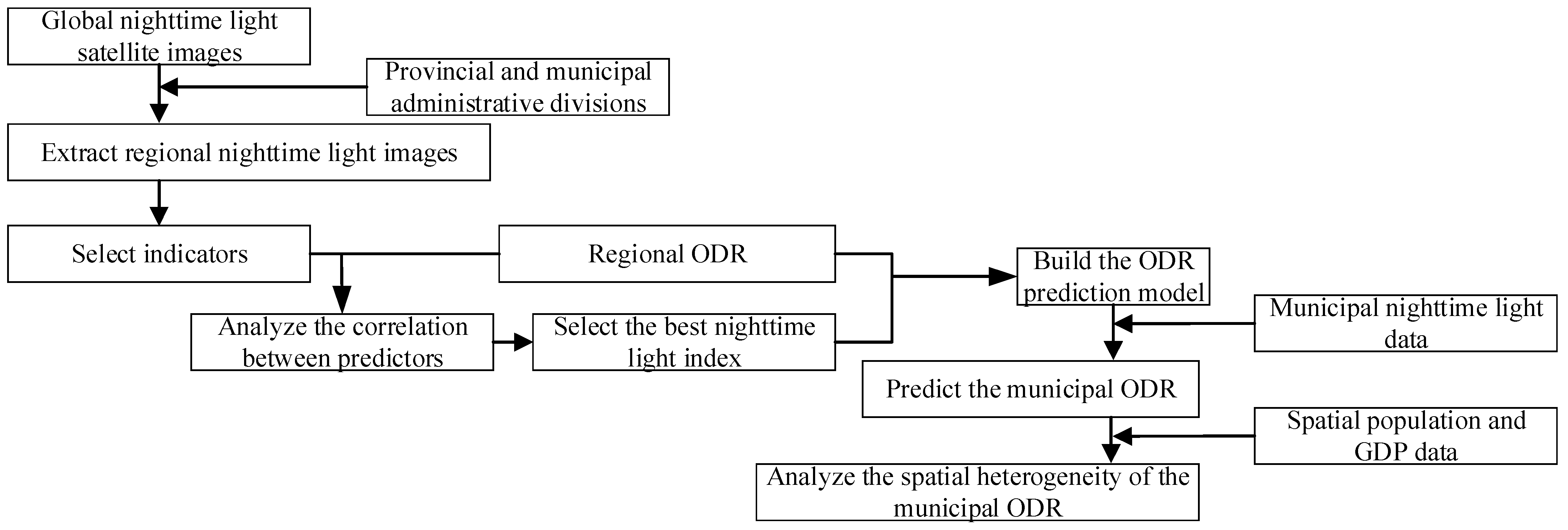

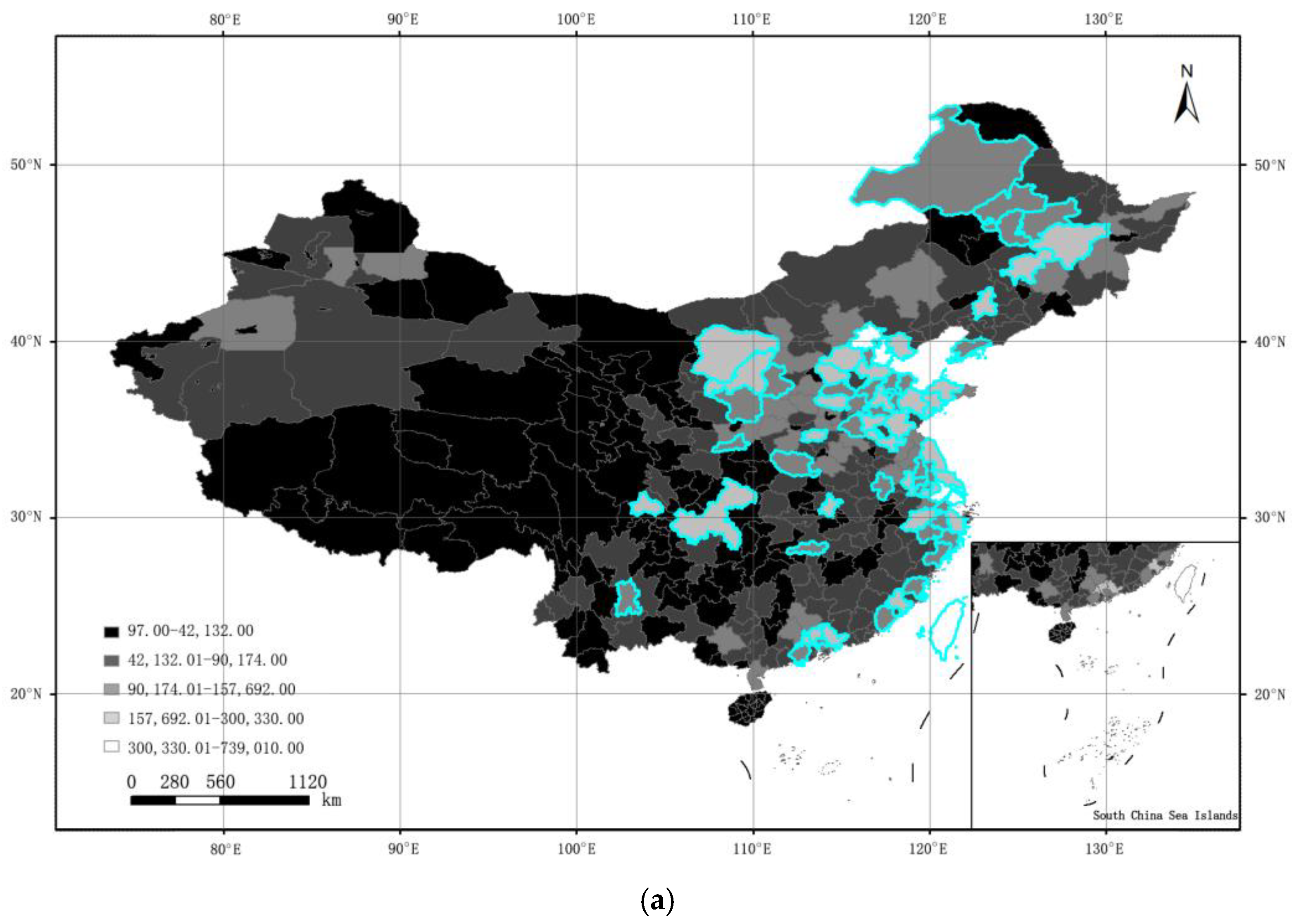
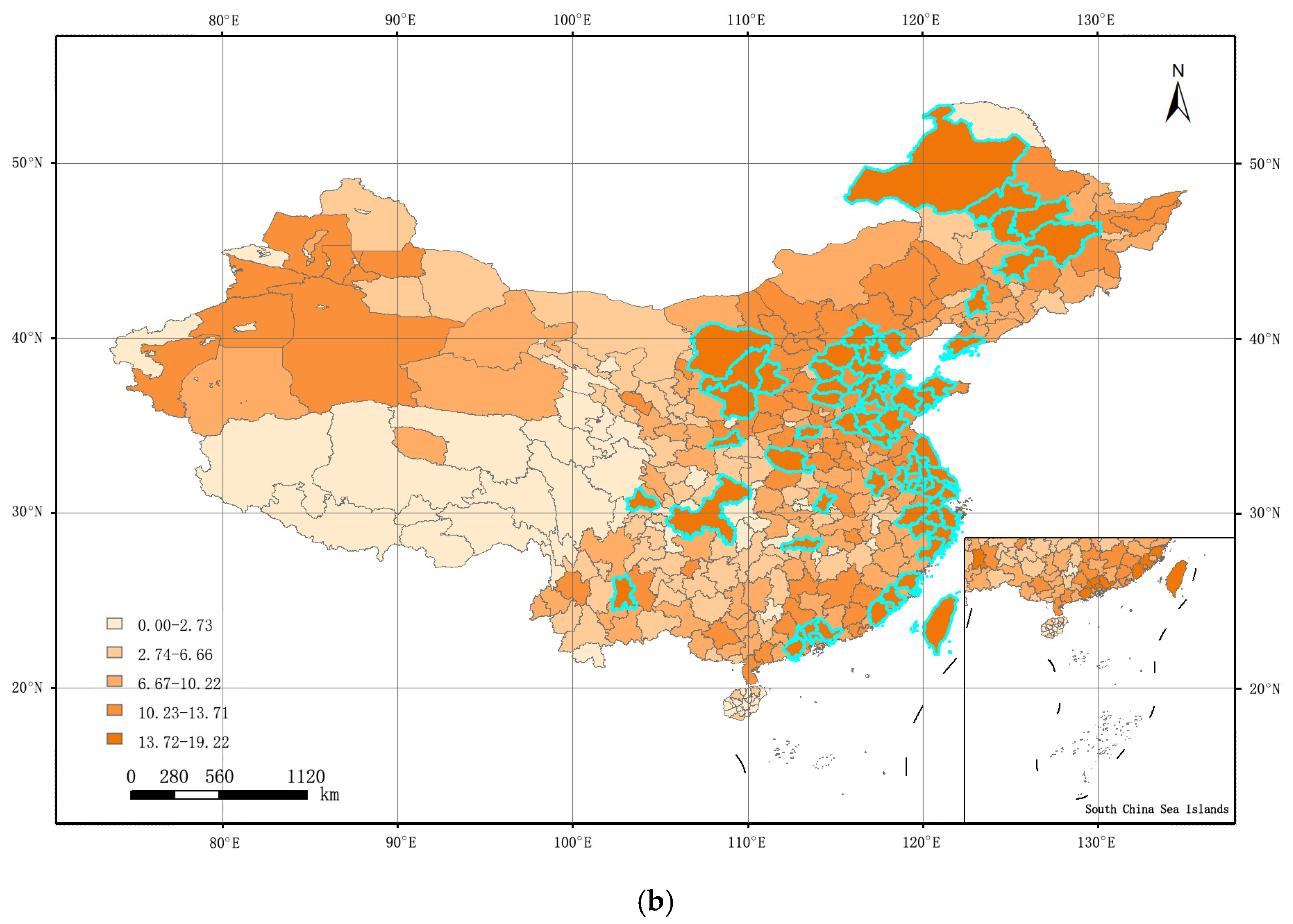
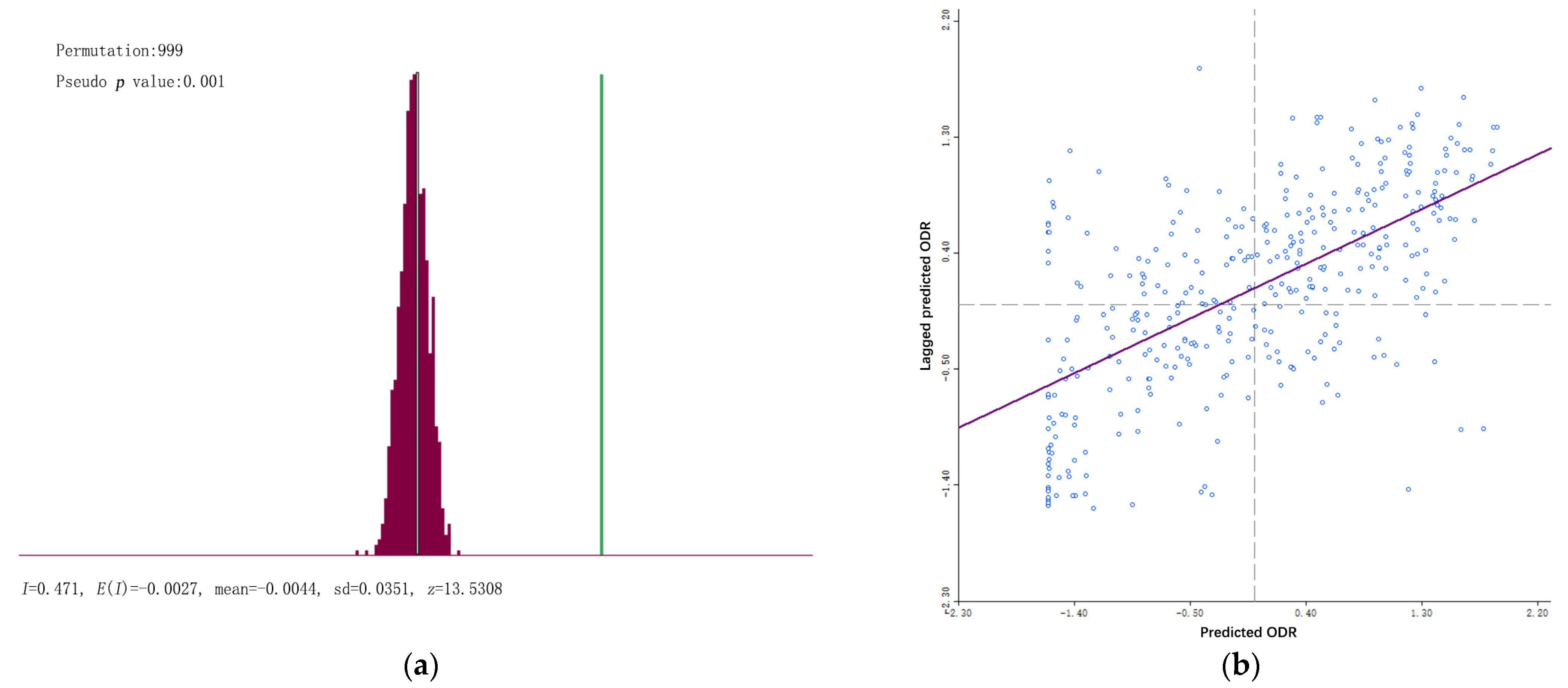
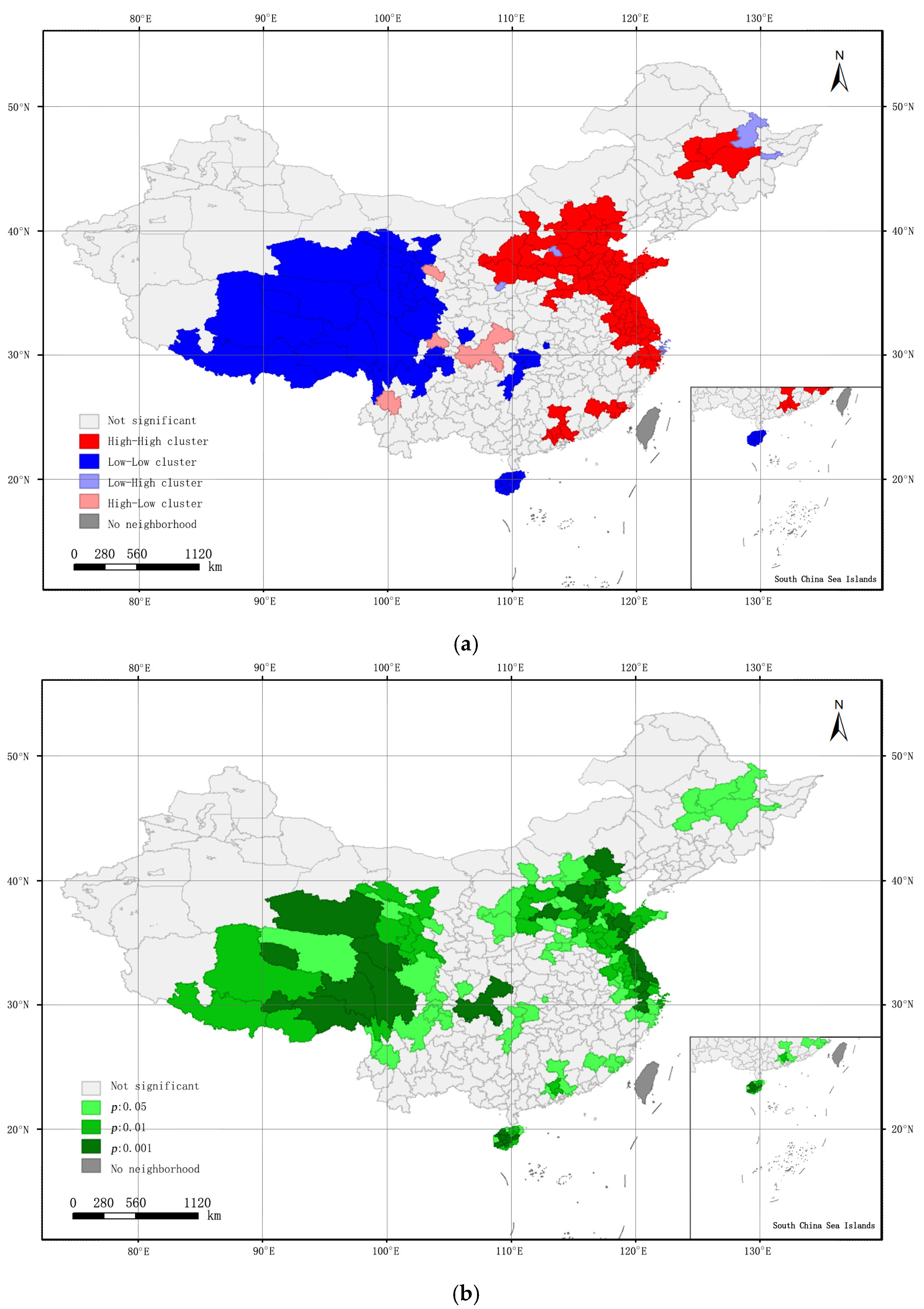

| Name | Source | Information |
|---|---|---|
| Population age structure and dependency ratios | National Bureau of Statistics of China (http://www.stats.gov.cn/tjsj/ndsj/2021/indexch.htm) accessed on 20 January 2022 | xls format |
| Global DMSP/OLS nighttime light data | NOAA official data center (https://ngdc.noaa.gov/eog/dmsp/downloadV4composites.html) accessed on 20 January 2022 | TIF format, WGS-84 projection |
| Spatial population and spatial GDP grid data | Resource and environment science and data center (https://www.resdc.cn/) accessed on 20 January 2022 | Gird format, Albers projection |
| Provincial and municipal administrative divisions | National geomatics center of China (http://www.ngcc.cn/) accessed on 20 January 2022 | Shapefile format |
| No. | Model | Expression | No. | Model | Expression |
|---|---|---|---|---|---|
| 1 | Linear | 7 | Power | ||
| 2 | Logarithmic | 8 | Sigmoid | ||
| 3 | Inverse | 9 | Growth | ||
| 4 | Quadratic | 10 | Exponential | ||
| 5 | Cubic | 11 | Logistic | ||
| 6 | Compound |
| Model | ODR_2011 | ODR_2012 | ODR_2013 | ODR_2014 | ODR_2015 | ODR_2016 | ODR_2017 | ODR_2018 | ODR_2019 | ODR_2020 | Mean |
|---|---|---|---|---|---|---|---|---|---|---|---|
| Linear | 0.043 | 0.031 | 0.029 | 0.050 | 0.064 | 0.067 | 0.076 | 0.135 | 0.121 | 0.075 | 0.069 |
| Logarithmic | 0.120 | 0.089 | 0.084 | 0.119 | 0.164 | 0.179 | 0.165 | 0.213 | 0.192 | 0.206 | 0.153 |
| Inverse | 0.177 | 0.153 | 0.171 | 0.169 | 0.238 | 0.280 | 0.226 | 0.234 | 0.217 | 0.302 | 0.217 |
| Quadratic | 0.062 | 0.038 | 0.030 | 0.061 | 0.100 | 0.106 | 0.102 | 0.144 | 0.130 | 0.141 | 0.091 |
| Cubic | 0.259 | 0.190 | 0.205 | 0.230 | 0.225 | 0.218 | 0.191 | 0.252 | 0.217 | 0.257 | 0.224 |
| Compound | 0.058 | 0.043 | 0.038 | 0.073 | 0.068 | 0.076 | 0.077 | 0.129 | 0.115 | 0.073 | 0.075 |
| Power | 0.170 | 0.127 | 0.123 | 0.178 | 0.201 | 0.234 | 0.198 | 0.253 | 0.228 | 0.244 | 0.196 |
| Sigmoid | 0.254 | 0.221 | 0.254 | 0.254 | 0.314 | 0.398 | 0.301 | 0.326 | 0.304 | 0.412 | 0.304 |
| Growth | 0.058 | 0.043 | 0.038 | 0.073 | 0.068 | 0.076 | 0.077 | 0.129 | 0.115 | 0.073 | 0.075 |
| Exponential | 0.058 | 0.043 | 0.038 | 0.073 | 0.068 | 0.076 | 0.077 | 0.129 | 0.115 | 0.073 | 0.075 |
| Logistic | 0.058 | 0.043 | 0.038 | 0.073 | 0.068 | 0.076 | 0.077 | 0.129 | 0.115 | 0.073 | 0.075 |
| No. | City | Municipal SUM of DN | Municipal ODR (%) | No. | City | Municipal SUM of DN | Municipal ODR (%) | No. | City | Municipal SUM of DN | Municipal ODR (%) |
|---|---|---|---|---|---|---|---|---|---|---|---|
| 1 | Suzhou | 373,261 | 18.076 | 23 | Wuxi | 186,016 | 15.948 | 45 | Jiaxing | 145,137 | 14.865 |
| 2 | Tianjin | 349,408 | 17.923 | 24 | Yulin | 180,977 | 15.838 | 46 | Xi’an | 144,576 | 14.847 |
| 3 | Beijing | 348,231 | 17.915 | 25 | Nanjing | 180,621 | 15.830 | 47 | Dongguan | 140,280 | 14.702 |
| 4 | Shanghai | 334,746 | 17.819 | 26 | Zhengzhou | 176,195 | 15.728 | 48 | Yan’an | 140,273 | 14.701 |
| 5 | Chongqing | 300,330 | 17.538 | 27 | Shijiazhuang | 174,421 | 15.686 | 49 | Jinhua | 139,724 | 14.682 |
| 6 | Harbin | 265,159 | 17.182 | 28 | Jinan | 173,470 | 15.663 | 50 | Taizhou | 139,068 | 14.659 |
| 7 | Guangzhou | 256,275 | 17.078 | 29 | Shenyang | 170,688 | 15.595 | 51 | Qiqihar | 138,330 | 14.633 |
| 8 | Tangshan | 254,191 | 17.053 | 30 | Handan | 170,627 | 15.593 | 52 | Xingtai | 136,448 | 14.566 |
| 9 | Weifang | 249,205 | 16.990 | 31 | Jining | 170,199 | 15.582 | 53 | Yangzhou | 136,258 | 14.559 |
| 10 | Ningbo | 232,518 | 16.765 | 32 | Wuhan | 170,083 | 15.580 | 54 | Binzhou | 136,179 | 14.556 |
| 11 | Nantong | 230,225 | 16.731 | 33 | Foshan | 169,524 | 15.566 | 55 | Taizhou | 135,832 | 14.543 |
| 12 | Chengdu | 223,101 | 16.624 | 34 | Huizhou | 167,721 | 15.520 | 56 | Hulunbeir | 135,027 | 14.513 |
| 13 | Yantai | 218,269 | 16.548 | 35 | Xuzhou | 166,657 | 15.492 | 57 | Luliang | 133,380 | 14.452 |
| 14 | Qingdao | 214,348 | 16.483 | 36 | Dalian | 157,692 | 15.249 | 58 | Changzhou | 133,260 | 14.447 |
| 15 | Linyi | 211,939 | 16.443 | 37 | Fuzhou | 156,327 | 15.210 | 59 | Jiangmen | 132,327 | 14.412 |
| 16 | Quanzhou | 210,609 | 16.420 | 38 | Kunming | 155,533 | 15.187 | 60 | Hefei | 132,237 | 14.409 |
| 17 | Hangzhou | 208,367 | 16.381 | 39 | Nanyang | 152,235 | 15.089 | 61 | Heze | 131,710 | 14.388 |
| 18 | Cangzhou | 200,063 | 16.230 | 40 | Langfang | 150,066 | 15.022 | 62 | Dezhou | 130,769 | 14.352 |
| 19 | Changchun | 197,844 | 16.188 | 41 | Daqing | 149,761 | 15.013 | 63 | Shaoxing | 126,333 | 14.174 |
| 20 | Baoding | 189,983 | 16.032 | 42 | Suihua | 146,411 | 14.907 | 64 | Changsha | 123,222 | 14.043 |
| 21 | Yancheng | 188,884 | 16.009 | 43 | Wenzhou | 145,549 | 14.879 | 65 | Dongying | 115,762 | 13.706 |
| 22 | Ordos | 187,564 | 15.981 | 44 | Zhangzhou | 145,227 | 14.868 |
| No. | City | Municipal ODR (%) | No. | City | Municipal ODR (%) | No. | City | Municipal ODR (%) | No. | City | Municipal ODR (%) |
|---|---|---|---|---|---|---|---|---|---|---|---|
| 1 | Suzhou | 18.076 | 22 | Shijiazhuang | 15.686 | 43 | Heze | 14.388 | 64 | Zhongshan | 12.231 |
| 2 | Tianjin | 17.923 | 23 | Jinan | 15.663 | 44 | Dezhou | 14.352 | 65 | Hengshui | 12.216 |
| 3 | Beijing | 17.915 | 24 | Handan | 15.593 | 45 | Shaoxing | 14.174 | 66 | Pingdingshan | 12.103 |
| 4 | Shanghai | 17.819 | 25 | Jining | 15.582 | 46 | Dongying | 13.706 | 67 | Datong | 11.513 |
| 5 | Harbin | 17.182 | 26 | Foshan | 15.566 | 47 | Xinxiang | 13.596 | 68 | Chengde | 11.051 |
| 6 | Guangzhou | 17.078 | 27 | Huizhou | 15.520 | 48 | Lianyungang | 13.574 | 69 | Zaozhuang | 10.961 |
| 7 | Tangshan | 17.053 | 28 | Xuzhou | 15.492 | 49 | Xinzhou | 13.430 | 70 | Xiamen | 10.823 |
| 8 | Weifang | 16.990 | 29 | Langfang | 15.022 | 50 | Zhenjiang | 13.404 | 71 | Rizhao | 10.822 |
| 9 | Ningbo | 16.765 | 30 | Daqing | 15.013 | 51 | Liaocheng | 13.404 | 72 | Longyan | 10.550 |
| 10 | Nantong | 16.731 | 31 | Suihua | 14.907 | 52 | Huai’an | 13.372 | 73 | Kaifeng | 9.968 |
| 11 | Yantai | 16.548 | 32 | Jiaxing | 14.865 | 53 | Zibo | 13.281 | 74 | Putian | 9.827 |
| 12 | Qingdao | 16.483 | 33 | Dongguan | 14.702 | 54 | Weihai | 13.164 | 75 | Songyuan | 9.614 |
| 13 | Linyi | 16.443 | 34 | Yan’an | 14.701 | 55 | Suqian | 13.162 | 76 | Shaoguan | 9.588 |
| 14 | Quanzhou | 16.420 | 35 | Jinhua | 14.682 | 56 | Linfen | 13.122 | 77 | Ma’anshan | 9.550 |
| 15 | Cangzhou | 16.230 | 36 | Taizhou | 14.659 | 57 | Hohhot | 12.910 | 78 | Puyang | 9.351 |
| 16 | Baoding | 16.032 | 37 | Xingtai | 14.566 | 58 | Jinzhong | 12.822 | 79 | Xuancheng | 8.701 |
| 17 | Yancheng | 16.009 | 38 | Yangzhou | 14.559 | 59 | Chuzhou | 12.660 | 80 | Yichun | 6.896 |
| 18 | Wuxi | 15.948 | 39 | Binzhou | 14.556 | 60 | Huzhou | 12.623 | 81 | Zhoushan | 6.095 |
| 19 | Yulin | 15.838 | 40 | Taizhou | 14.543 | 61 | Changzhi | 12.496 | 82 | Qitaihe | 5.565 |
| 20 | Nanjing | 15.830 | 41 | Luliang | 14.452 | 62 | Zhangjiakou | 12.471 | 83 | Yangquan | 4.734 |
| 21 | Zhengzhou | 15.728 | 42 | Changzhou | 14.447 | 63 | Tai’an | 12.466 | 84 | Tongchuan | 2.040 |
| Municipal ODR | Municipal SUM of DN | Spatial Population | Spatial GDP | |
|---|---|---|---|---|
| Municipal ODR | 1 | |||
| Municipal SUM of DN | 0.820 ** | 1 | ||
| Spatial population | 0.675 ** | 0.674 ** | 1 | |
| Spatial GDP | 0.594 ** | 0.702 ** | 0.816 ** | 1 |
| City | Municipal ODR (%) | City | Municipal SUM of DN | City | Spatial Population | City | Spatial GDP |
|---|---|---|---|---|---|---|---|
| Suzhou | 18.076 | Suzhou | 373,261 | Chongqing | 30,959,389 | Shanghai | 261,830,605 |
| Tianjin | 17.923 | Tianjin | 349,408 | Shanghai | 23,876,188 | Beijing | 217,296,830 |
| Beijing | 17.915 | Beijing | 348,231 | Beijing | 21,690,535 | Tianjin | 187,427,119 |
| Shanghai | 17.819 | Shanghai | 334,746 | Tianjin | 15,425,497 | Guangzhou | 180,167,046 |
| Chongqing | 17.538 | Chongqing | 300,330 | Chengdu | 15,220,175 | Chongqing | 147,182,175 |
| Harbin | 17.182 | Harbin | 265,159 | Guangzhou | 13,439,208 | Suzhou | 133,678,096 |
| Guangzhou | 17.078 | Guangzhou | 256,275 | Yichun | 12,562,974 | Chengdu | 96,746,196 |
| Tangshan | 17.053 | Tangshan | 254,191 | Baoding | 11,946,975 | Qingdao | 91,469,755 |
| Weifang | 16.990 | Weifang | 249,205 | Suzhou | 10,738,576 | Changsha | 90,364,523 |
| Ningbo | 16.765 | Ningbo | 232,518 | Wuhan | 10,568,583 | Wuxi | 86,232,644 |
| Nantong | 16.731 | Nantong | 230,225 | Linyi | 10,410,237 | Hangzhou | 86,143,887 |
| Chengdu | 16.624 | Chengdu | 223,101 | Handan | 10,220,940 | Yangzhou | 85,564,657 |
| Yantai | 16.548 | Yantai | 218,269 | Nanyang | 10,100,919 | Wuhan | 80,912,736 |
| Qingdao | 16.483 | Qingdao | 214,348 | Shijiazhuang | 10,077,521 | Foshan | 80,506,132 |
| Linyi | 16.443 | Linyi | 211,939 | Harbin | 9,278,484 | Dongguan | 79,439,884 |
| Quanzhou | 16.420 | Quanzhou | 210,609 | Weifang | 9,275,444 | Nanjing | 76,500,052 |
| Hangzhou | 16.381 | Hangzhou | 208,367 | Wenzhou | 9,063,728 | Ningbo | 76,441,765 |
| Cangzhou | 16.230 | Cangzhou | 200,063 | Qingdao | 8,989,079 | Shenyang | 70,454,732 |
| Changchun | 16.188 | Changchun | 197,844 | Zhoukou | 8,903,463 | Dalian | 69,840,050 |
| Baoding | 16.032 | Baoding | 189,983 | Heze | 8,793,076 | Zhengzhou | 69,838,666 |
Publisher’s Note: MDPI stays neutral with regard to jurisdictional claims in published maps and institutional affiliations. |
© 2022 by the authors. Licensee MDPI, Basel, Switzerland. This article is an open access article distributed under the terms and conditions of the Creative Commons Attribution (CC BY) license (https://creativecommons.org/licenses/by/4.0/).
Share and Cite
Li, Y.; Zhang, C.; Tong, Y.; Zhang, Y.; Chen, G. Prediction of the Old-Age Dependency Ratio in Chinese Cities Using DMSP/OLS Nighttime Light Data. Int. J. Environ. Res. Public Health 2022, 19, 7179. https://doi.org/10.3390/ijerph19127179
Li Y, Zhang C, Tong Y, Zhang Y, Chen G. Prediction of the Old-Age Dependency Ratio in Chinese Cities Using DMSP/OLS Nighttime Light Data. International Journal of Environmental Research and Public Health. 2022; 19(12):7179. https://doi.org/10.3390/ijerph19127179
Chicago/Turabian StyleLi, Yue, Chengmeng Zhang, Yan Tong, Yalu Zhang, and Gong Chen. 2022. "Prediction of the Old-Age Dependency Ratio in Chinese Cities Using DMSP/OLS Nighttime Light Data" International Journal of Environmental Research and Public Health 19, no. 12: 7179. https://doi.org/10.3390/ijerph19127179






